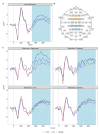Electrophysiological Correlates of Vocal Emotional Processing in Musicians and Non-Musicians
- PMID: 38002523
- PMCID: PMC10670383
- DOI: 10.3390/brainsci13111563
Electrophysiological Correlates of Vocal Emotional Processing in Musicians and Non-Musicians
Abstract
Musicians outperform non-musicians in vocal emotion recognition, but the underlying mechanisms are still debated. Behavioral measures highlight the importance of auditory sensitivity towards emotional voice cues. However, it remains unclear whether and how this group difference is reflected at the brain level. Here, we compared event-related potentials (ERPs) to acoustically manipulated voices between musicians (n = 39) and non-musicians (n = 39). We used parameter-specific voice morphing to create and present vocal stimuli that conveyed happiness, fear, pleasure, or sadness, either in all acoustic cues or selectively in either pitch contour (F0) or timbre. Although the fronto-central P200 (150-250 ms) and N400 (300-500 ms) components were modulated by pitch and timbre, differences between musicians and non-musicians appeared only for a centro-parietal late positive potential (500-1000 ms). Thus, this study does not support an early auditory specialization in musicians but suggests instead that musicality affects the manner in which listeners use acoustic voice cues during later, controlled aspects of emotion evaluation.
Keywords: electrophysiological correlates; fundamental frequency (F0); musicality; parameter-specific voice morphing; timbre; vocal emotion perception.
Conflict of interest statement
The authors declare no conflict of interest.
Figures




Similar articles
-
Vocal Emotion Perception and Musicality-Insights from EEG Decoding.Sensors (Basel). 2025 Mar 8;25(6):1669. doi: 10.3390/s25061669. Sensors (Basel). 2025. PMID: 40292745 Free PMC article.
-
Musicality - Tuned to the melody of vocal emotions.Br J Psychol. 2024 May;115(2):206-225. doi: 10.1111/bjop.12684. Epub 2023 Oct 18. Br J Psychol. 2024. PMID: 37851369
-
Contributions of fundamental frequency and timbre to vocal emotion perception and their electrophysiological correlates.Soc Cogn Affect Neurosci. 2022 Dec 1;17(12):1145-1154. doi: 10.1093/scan/nsac033. Soc Cogn Affect Neurosci. 2022. PMID: 35522247 Free PMC article.
-
Vocal emotion adaptation aftereffects within and across speaker genders: Roles of timbre and fundamental frequency.Cognition. 2022 Feb;219:104967. doi: 10.1016/j.cognition.2021.104967. Epub 2021 Dec 4. Cognition. 2022. PMID: 34875400
-
Specialization of the specialized: electrophysiological investigations in professional musicians.Ann N Y Acad Sci. 2003 Nov;999:131-9. doi: 10.1196/annals.1284.014. Ann N Y Acad Sci. 2003. PMID: 14681126 Review.
Cited by
-
Vocal Emotion Perception and Musicality-Insights from EEG Decoding.Sensors (Basel). 2025 Mar 8;25(6):1669. doi: 10.3390/s25061669. Sensors (Basel). 2025. PMID: 40292745 Free PMC article.
References
-
- Scherer K.R. Acoustic Patterning of Emotion Vocalizations. In: Frühholz S., Belin P., Frühholz S., Belin P., Scherer K.R., editors. The Oxford Handbook of Voice Perception. Oxford University Press; Oxford, UK: 2018. pp. 60–92.
-
- Paulmann S., Kotz S.A. The Electrophysiology and Time Course of Processing Vocal Emotion Expressions. In: Frühholz S., Belin P., Frühholz S., Belin P., Scherer K.R., editors. The Oxford Handbook of Voice Perception. Oxford University Press; Oxford, UK: 2018. pp. 458–472.
LinkOut - more resources
Full Text Sources

